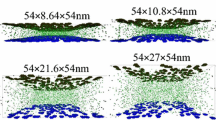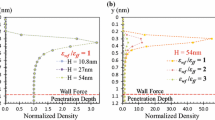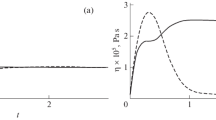Abstract
Molecular dynamics simulations of static argon gas at three different levels of rarefaction are conducted for a channel of 5.4 nm height to investigate the simultaneous effect of the wall force field and the gas temperature on the stress distribution along the channel height. Using the interactive thermal wall model, different temperatures are applied on the channel walls to be able to investigate the effect of the wall temperature and the induced heat flux through the gas medium on the stress distribution. Considering the monoatomic neutral argon gas, the kinetic, particle-particle virial, and surface-particle virial are considered for computing the stress distribution along the channel height. The normal stress components in the bulk gas region are distributed isotropically regardless of the gas density, temperature, and induced heat flux through the domain, while an anisotropy is observed due to the presence of the surface-particle virial. As the gas becomes hotter, the velocity of the gas atoms increases, and thus the kinetic stress component also increases. Besides, the gas density in the wall force field region reduces which eventually attenuates the surface-particle and particle-particle virial stress within 1 nm from each wall. This effect was also observed as the gas becomes cooler. It is shown that the combination of gas density, wall temperature, and induced heat flux are the main parameters which determine the distribution of stress within the gas medium especially in the wall force field region where repulsive and attractive interactions exist.








Similar content being viewed by others
References
Chen Z, Wong C, Lubner S et al (2014) A photon thermal diode. Nat Commun 5:5446
Li N, Ren J, Wang L et al (2012) Colloquium: phononics: manipulating heat flow with electronic analogs and beyond. Rev Mod Phys 84:1045–1066. https://doi.org/10.1103/RevModPhys.84.1045
Wang L, Li B (2007) Thermal logic gates: computation with phonons. Phys Rev Lett 99:177208. https://doi.org/10.1103/PhysRevLett.99.177208
Casati G (2007) Device physics: the heat is on - and off. Nat Nanotechnol 2:23–24. https://doi.org/10.1038/nnano.2006.191
Roberts NA, Walker DG (2011) Computational study of thermal rectification from nanostructured interfaces. J Heat Transf 133:092401. https://doi.org/10.1115/1.4003960
Kuo DMT, Chang YC (2010) Thermoelectric and thermal rectification properties of quantum dot junctions. Phys Rev B - Condens Matter Mater Phys 81:205321. https://doi.org/10.1103/PhysRevB.81.205321
Varga S, Oliveira AC, Afonso CF (2002) Characterisation of thermal diode panels for use in the cooling season in buildings. Energy Build 34:227–235. https://doi.org/10.1016/S0378-7788(01)00090-1
Giannakopoulos AE, Sofos F, Karakasidis TE, Liakopoulos A (2012) Unified description of size effects of transport properties of liquids flowing in nanochannels. Int J Heat Mass Transf 55:5087–5092. https://doi.org/10.1016/j.ijheatmasstransfer.2012.05.008
Chen Y, Zhang C (2014) Role of surface roughness on thermal conductance at liquid–solid interfaces. Int J Heat Mass Transf 78:624–629. https://doi.org/10.1016/J.IJHEATMASSTRANSFER.2014.07.005
Rajabpour A, Seif R, Arabha S et al (2019) Thermal transport at a nanoparticle-water interface: a molecular dynamics and continuum modeling study. J Chem Phys 150:114701. https://doi.org/10.1063/1.5084234
Heyhat MM, Rajabpour A, Abbasi M, Arabha S (2018) Importance of nanolayer formation in nanofluid properties: equilibrium molecular dynamic simulations for Ag-water nanofluid. J Mol Liq 264:699–705. https://doi.org/10.1016/j.molliq.2018.05.122
Merabia S, Shenogin S, Joly L et al (2009) Heat transfer from nanoparticles: a corresponding state analysis. Proc Natl Acad Sci 106:15113–15118. https://doi.org/10.1073/pnas.0901372106
Merabia S, Keblinski P, Joly L et al (2009) Critical heat flux around strongly heated nanoparticles. Phys Rev E - Stat Nonlinear, Soft Matter Phys 79:021404. https://doi.org/10.1103/PhysRevE.79.021404
Fu L, Merabia S, Joly L (2018) Understanding fast and robust thermo-osmotic flows through carbon nanotube membranes: thermodynamics meets hydrodynamics. J Phys Chem Lett 9:2086–2092. https://doi.org/10.1021/acs.jpclett.8b00703
Pham AT, Barisik M, Kim B (2014) Molecular dynamics simulations of Kapitza length for argon-silicon and water-silicon interfaces. Int J Precis Eng Manuf 15:323–329. https://doi.org/10.1007/s12541-014-0341-x
Faraji F, Rajabpour A (2017) Fluid heating in a nano-scale Poiseuille flow: a non-equilibrium molecular dynamics study. Curr Appl Phys 17:1646–1654. https://doi.org/10.1016/j.cap.2017.09.008
Fu T, Wang Q (2018) Effect of nanostructure on heat transfer between fluid and copper plate: a molecular dynamics simulation study. Mol Simul:1–6. https://doi.org/10.1080/08927022.2018.1431836
Zhang L, Xu J, Chen Q, Wang S (2018) Switchable heat transfer in nano Janus-interface-system. Int J Heat Mass Transf 127:761–771. https://doi.org/10.1016/j.ijheatmasstransfer.2018.07.090
Hens A, Agarwal R, Biswas G (2014) Nanoscale study of boiling and evaporation in a liquid Ar film on a Pt heater using molecular dynamics simulation. Int J Heat Mass Transf 71:303–312. https://doi.org/10.1016/J.IJHEATMASSTRANSFER.2013.12.032
Ghorbanian J, Beskok A (2016) Scale effects in nano-channel liquid flows. Microfluid Nanofluid 20:121. https://doi.org/10.1007/s10404-016-1790-6
Ueki Y, Miyazaki Y, Shibahara M, Ohara T (2018) Molecular dynamics study of thermal resistance of solid-liquid interface in contact with single layer of nanoparticles. Int J Heat Mass Transf 120:608–623. https://doi.org/10.1016/j.ijheatmasstransfer.2017.12.061
Hartkamp R, Ghosh A, Weinhart T, Luding S (2012) A study of the anisotropy of stress in a fluid confined in a nanochannel. J Chem Phys 137:044711. https://doi.org/10.1063/1.4737927
Barisik M, Kim B, Beskok A (2010) Smart wall model for molecular dynamics simulations of nanoscale gas flows. Commun Comput Phys 7:977–993. https://doi.org/10.4208/cicp.2009.09.118
Rabani R, Heidarinejad G, Harting J, Shirani E (2018) Interplay of confinement and density on the heat transfer characteristics of nanoscale-confined gas. Int J Heat Mass Transf 126:331–341. https://doi.org/10.1016/j.ijheatmasstransfer.2018.05.028
Rabani R, Heidarinejad G, Harting J, Shirani E (2019) Effect of temperature difference between channel walls on the heat transfer characteristics of nanoscale-confined gas. Int J Therm Sci 137:13–25
Rabani R, Heidarinejad G, Harting J, Shirani E (2020) Heat conduction characteristic of rarefied gas in nanochannel. J Appl Fluid Mech 13:1–13. https://doi.org/10.29252/jafm.13.01.30075
Bao F, Mao Z, Qiu L (2014) Study of gaseous velocity slip in nano-channel using molecular dynamics simulation. Int J Numer Methods Heat Fluid Flow 24:1338–1347. https://doi.org/10.1108/HFF-04-2013-0145
Cieplak M, Koplik J, Bavanar JR (2000) Molecular dynamics of flows in the Knudsen regime. Phys A Stat Mech Appl 287:153–160. https://doi.org/10.1016/S0378-4371(00)00353-8
Bao F, Huang Y, Zhang Y, Lin J (2015) Investigation of pressure-driven gas flows in nanoscale channels using molecular dynamics simulation. Microfluid Nanofluid 18:1075–1084. https://doi.org/10.1007/s10404-014-1498-4
Bao F, Huang Y, Qiu L, Lin J (2015) Applicability of molecular dynamics method to the pressure-driven gas flow in finite length nano-scale slit pores. Mol Phys 113:561–569. https://doi.org/10.1080/00268976.2014.960495
Zhou W-J, Yu Z-Q, Li Z-Z et al (2017) Atomistic-continuum hybrid simulations for compressible gas flow in a parallel nanochannel. Int J Heat Mass Transf 108:2100–2106. https://doi.org/10.1016/J.IJHEATMASSTRANSFER.2017.01.042
Kammara KK, Malaikannan G, Kumar R (2016) Molecular dynamics study of gas–surface interactions in a force-driven flow of argon through a rectangular nanochannel. Nanoscale Microscale Thermophys Eng 20:121–136. https://doi.org/10.1080/15567265.2016.1215364
Yasuoka H, Kaneda M, Suga K (2016) Wall-adjacent velocity profiles of nano-scale gas flows. J Stat Phys 165:907–919. https://doi.org/10.1007/s10955-016-1662-1
Barisik M, Beskok A, Levin DA, et al (2011) MD simulations of nano-scale gas flows: a case study of Couette flow at Kn= 10. In: AIP Conference Proceedings-American Institute of Physics. p 707
Barisik M, Beskok A (2011) Molecular dynamics simulations of shear-driven gas flows in nano-channels. Microfluid Nanofluid 11:611–622. https://doi.org/10.1007/s10404-011-0827-0
Barisik M, Beskok A (2011) Equilibrium molecular dynamics studies on nanoscale-confined fluids. Microfluid Nanofluid 11:269–282. https://doi.org/10.1007/s10404-011-0794-5
Barisik M, Beskok A (2012) Surface-gas interaction effects on nanoscale gas flows. Microfluid Nanofluid 13:789–798. https://doi.org/10.1007/s10404-012-1000-0
Barisik M, Beskok A (2014) Scale effects in gas nano flows. Phys Fluids 26:052003. https://doi.org/10.1063/1.4874678
Barisik M, Beskok A (2015) Molecular free paths in nanoscale gas flows. Microfluid Nanofluid 18:1365–1371. https://doi.org/10.1007/s10404-014-1535-3
Barisik M, Beskok A (2016) “Law of the nano-wall” in nano-channel gas flows. Microfluid Nanofluid 20:1–9. https://doi.org/10.1007/s10404-016-1713-6
Irving JH, Kirkwood JG (1950) The statistical mechanical theory of transport processes. IV. The Equations of Hydrodynamics. J Chem Phys 18:817–829. https://doi.org/10.1063/1.1747782
Kim JH, Frijns AJH, Nedea SV, van Steenhoven AA (2012) Pressure calculations in Nanochannel gas flows. J Phys Conf Ser 362:012020. https://doi.org/10.1088/1742-6596/362/1/012020
Qian L, Tu C, Bao F, Zhang Y (2016) Virtual-Wall model for molecular dynamics simulation. Molecules 21:1678. https://doi.org/10.3390/molecules21121678
Kim BH, Beskok A, Cagin T (2008) Thermal interactions in nanoscale fluid flow: molecular dynamics simulations with solid-liquid interfaces. Microfluid Nanofluid 5:551–559. https://doi.org/10.1007/s10404-008-0267-7
Ghassem H, Reza R, Ebrahim S (2017) The effect of wall force field on temperature distribution in nanochannel contains Lennard-Jones fluid by molecular dynamic simulation. Modares Mech Eng 17:23–31
Rabani R, Heidarinejad G, Harting J, Shirani E (2020) Effect of wall stiffness, mass and potential interaction strength on heat transfer characteristics of nanoscale-confined gas. Int J Heat Mass Transf 147:118929. https://doi.org/10.1016/j.ijheatmasstransfer.2019.118929
Rabani R, Heidarinejad G, Harting J, Shirani E (2020) Interplay of wall force field and wall physical characteristics on interfacial phenomena of a nano-confined gas medium. Int J Therm Sci 153:106394. https://doi.org/10.1016/j.ijthermalsci.2020.106394
Plimpton S (1995) Fast parallel algorithms for short-range molecular dynamics. J Comput Phys 117:1–19. https://doi.org/10.1006/jcph.1995.1039
London F (1937) The general theory of molecular forces. Trans Faraday Soc 33:8–26. https://doi.org/10.1039/tf937330008b
Allen MP, Tildesley DJ (1987) Computer simulation of liquids. Clarendon Press
Allen MP, Tildesley DJ, Banavar JR (1989) Computer simulation of liquids. Phys Today 42:105–106. https://doi.org/10.1063/1.2810937
Surblys D, Matsubara H, Kikugawa G, Ohara T (2019) Application of atomic stress to compute heat flux via molecular dynamics for systems with many-body interactions. Phys Rev E 99. https://doi.org/10.1103/PhysRevE.99.051301
Author information
Authors and Affiliations
Corresponding author
Additional information
Publisher’s note
Springer Nature remains neutral with regard to jurisdictional claims in published maps and institutional affiliations.
Rights and permissions
About this article
Cite this article
Rabani, R., Heidarinejad, G., Harting, J. et al. Thermally induced stress in a nanoconfined gas medium. J Mol Model 26, 180 (2020). https://doi.org/10.1007/s00894-020-04443-z
Received:
Accepted:
Published:
DOI: https://doi.org/10.1007/s00894-020-04443-z




